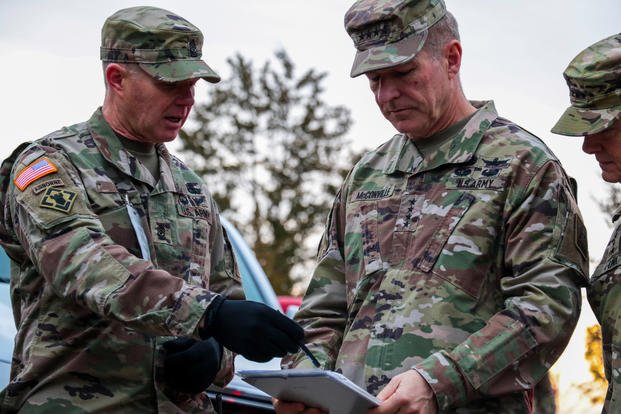On the heels of reporting on an Army memo stating that service efforts to stop the spread of the novel coronavirus had so far been 'insufficient,' the Chief of Staff of the Army provided new insights on the way social distancing in the ranks is being maintained, acknowledging that in many places the attempt is not to keep individual soldiers six feet apart, but to isolate small groups.
"It's almost that you want to create bubbles and keep a small amount of people in that bubble," Gen. James McConville told reporters at a Thursday afternoon briefing from the Pentagon. "Because if one person comes up with the virus, then you don't get into that exponential growth that we see when ... people are touching a whole bunch of people."
McConville cited the Army squad, which has 10 soldiers, as the typical size for the "bubbles" he referenced.
"From where we sit, the best thing we can do is keep the exposure or the circle that people run in very, very small," he said. "You keep your circles very, very small, and that's how you flatten the curve."
When possible in training, he noted, the Army is still putting space between individual soldiers.
"When we maneuver a squad, we usually have five meters in between members, just in case ... in a tactical situation, because of the threat," he said. "In this case this is an invisible threat, but we still need to keep that distance ... there are soldiers that need to perform critical functions around the world, and they will continue to do that based on the commander's assessment of the threat to the force and the threat to the mission."
Related: Military Announces New Hardship Pay for Troops in Quarantine
As of Thursday, there were 288 cases of COVID-19 within the Army: 100 among soldiers and the rest among service civilians, contractors and dependents. Cases among soldiers represented more than a third of the 280 cases reported from all U.S. troops.
McConville acknowledged a message from the Department of the Army to tenant commands, first reported by Task and Purpose that found "mitigation measures taken by the U.S. Army to blunt the spread of COVID-19 have proven insufficient" and urged commanders to do more to curtail transmission.
"I think what led us to that conclusion is ... we see it's started to increase around the country. So what we're trying to do is put the appropriate measures in place to protect the force," he said. "And each of these commanders is doing a trade-off. They know they have a wartime mission that they have to train for. They also know they need to protect the force or they're not going to be ready when they're called."
This week, Army installations around the globe went to Health Protection Condition Charlie, the second-highest security level, limiting base access to essential personnel and closing some gates. The 82nd Airborne, the Army's contingency response forces, was placed in HPCON Delta conditions, meaning they are largely confined at home to limit the risk of infection.
McConville said top Army officials had been "going to school" on virus management with insights from Gen. Robert Abrams, commander of U.S. Forces Korea, who has emerged as a profile on successful leadership after locking down bases in the country to stem the spread of COVID-19.
"We are winning!" U.S. Army Garrison Daegu tweeted March 16 as new virus cases on the peninsula began to decrease and some personnel prepared to return to work.
McConville said it was more challenging to implement the kind of lockdown protocols across the United States that had been implemented in Korea, noting that each command had to balance the needs of its mission and training requirements with safety guidelines. But, he said, while physical training might be a persistent requirement, for example, formation runs were not.
"I think we need to do more to limit exposure, especially for those who are not doing mission-essential tasks," he said. "So that's what we're really saying right now, is when we look at our commands, we say, "Do you -- do you really have to do this task that may increase the risk to our soldiers? Or if you have to do that task, then how can you make it a little safer?"
-- Hope Hodge Seck can be reached at hope.seck@military.com. Follow her on Twitter at @HopeSeck.
Read More: Army Asks Retired Soldiers in Health Care Fields to Come Back for COVID-19 Fight













